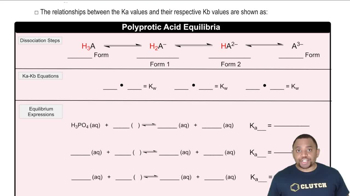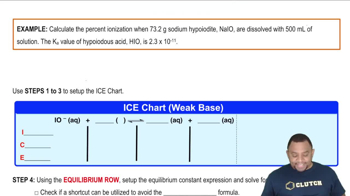Here are the essential concepts you must grasp in order to answer the question correctly.
Acid-Base Equilibrium
Acid-base equilibrium refers to the balance between the concentrations of an acid and its conjugate base in a solution. For weak acids like hydrofluoric acid (HF), this equilibrium is described by the acid dissociation constant (Ka), which quantifies the extent to which the acid donates protons (H+) to the solution. Understanding this concept is crucial for calculating pH and percent ionization.
Recommended video:
Triprotic Acid Equilibrium
pH Calculation
pH is a measure of the acidity or basicity of a solution, defined as the negative logarithm of the hydrogen ion concentration (pH = -log[H+]). For weak acids, the pH can be calculated using the concentration of the acid and its dissociation constant (Ka). This involves setting up an equilibrium expression and solving for [H+], which is then used to find the pH.
Recommended video:
Percent Ionization
Percent ionization is a measure of the degree to which a weak acid dissociates in solution, expressed as the ratio of the concentration of ionized acid to the initial concentration of the acid, multiplied by 100. It provides insight into the strength of the acid; weaker acids have lower percent ionization. This concept is essential for comparing the ionization of different concentrations of HF in the given problem.
Recommended video:
Percent Ionization Example
 Verified step by step guidance
Verified step by step guidance

